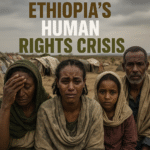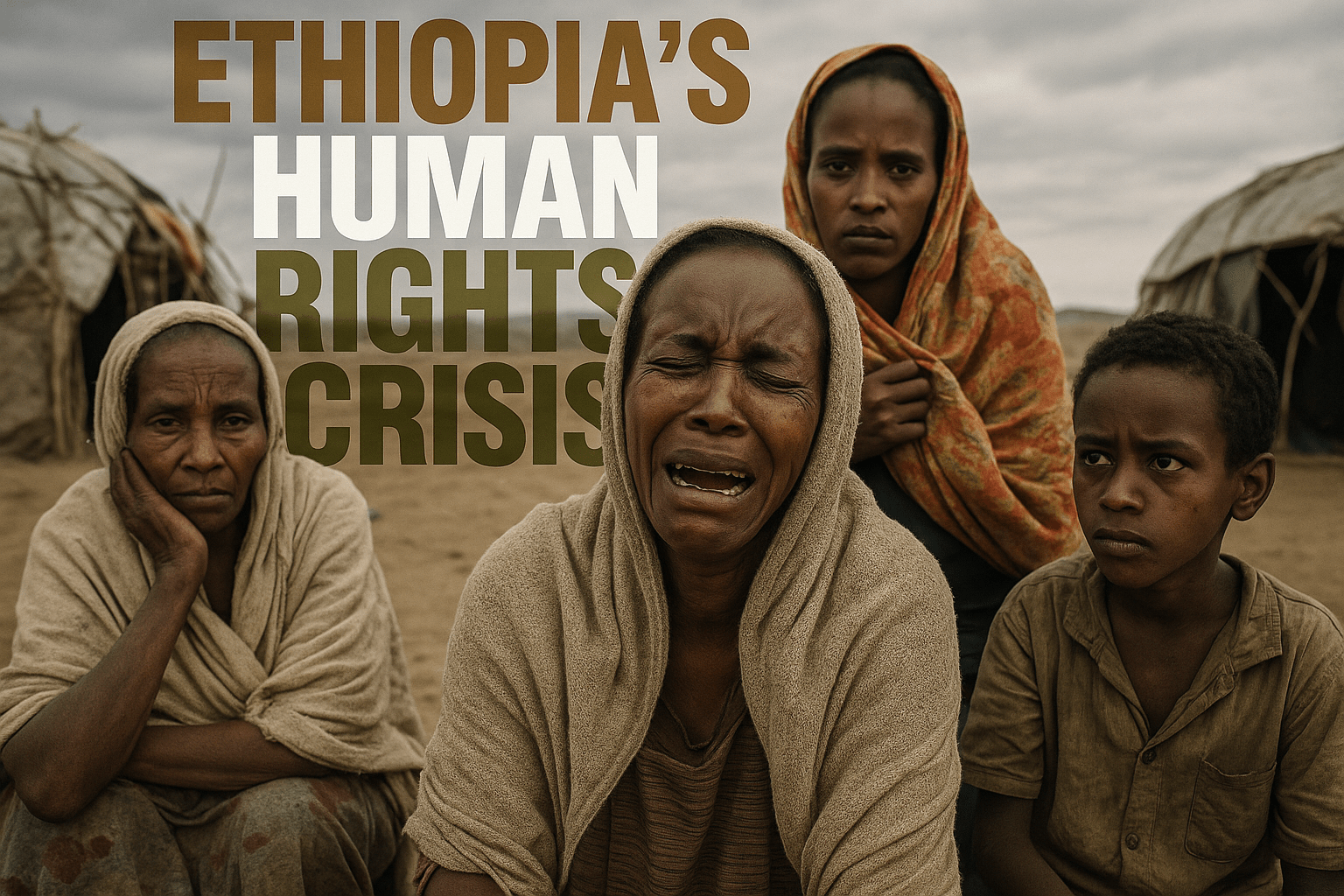

Ethiopia's Human Rights Crisis Deepens
By Darius Spearman (africanelements)
Support African Elements at patreon.com/africanelements and hear recent news in a single playlist. Additionally, you can gain early access to ad-free video content.
Ethiopia's Troubled Regions
The United States Department of State has voiced significant alarm regarding human rights violations in Ethiopia, particularly within the Amhara and Oromia regions (thereporterethiopia.com). These two regions are among Ethiopia's largest and most populated, each holding distinct ethnic and political importance. The Amhara region is predominantly home to the Amhara ethnic group, while the Oromia region is inhabited by the Oromo people, who represent Ethiopia's largest ethnic group. Both areas have endured severe human rights abuses, often stemming from inter-ethnic conflicts, government crackdowns, and persistent political instability.
A senior US Department of State official, Under-Secretary of State Uzra Zeya, highlighted Washington's concern over ongoing hostilities and the involvement of both government troops and non-state actors in committing crimes (thereporterethiopia.com). Zeya called for unrestricted access for independent human rights monitors and impartial investigations to ensure accountability for perpetrators (thereporterethiopia.com). The annual Country Reports on Human Rights Practices, compiled by the U.S. Department of State, cover internationally recognized individual, civil, political, and worker rights, drawing from various credible sources including government agencies, NGOs, and media (state.gov).
Understanding Non-State Actors
Non-state actors and militias in Ethiopia are armed groups operating outside direct government control. These groups often have specific ethnic, political, or regional affiliations. Their motivations vary, ranging from defending perceived community interests to seeking greater autonomy or engaging in opportunistic violence. These groups have been implicated in numerous human rights abuses, contributing to the complex and multi-faceted nature of conflicts in Ethiopia.
The Ethiopian government has faced criticism for failing to effectively investigate violations and for initiating a flawed transitional justice process, despite commitments to accountability (hrw.org). The UN's report further highlights the inability of the Ethiopian Federal Government to carry out commitments on human rights, transitional justice, and territorial integrity (visionofhumanity.org). This lack of effective oversight allows these non-state actors to continue their activities with little fear of repercussions.
Impact of State of Emergency
Clashes between the Ethiopian military and militias, particularly in the Amhara region, have led to significant civilian casualties and displacement (hrw.org). In August 2023, these clashes escalated, resulting in hundreds of civilian deaths and injuries, destruction of civilian infrastructure, and widespread displacement (hrw.org). The federal government responded by implementing a sweeping state of emergency for the Amhara region, with provisions often applied throughout the country (hrw.org).
A state of emergency in Ethiopia grants the government extraordinary powers, often leading to significant restrictions on civil liberties and democratic governance. These powers can include arbitrary arrests, detentions without charge, limitations on freedom of assembly and speech, and increased surveillance. Such measures are typically implemented in response to perceived national security threats or widespread unrest. However, their application often raises concerns about human rights abuses and the erosion of the rule of law. The Ethiopian government has a history of launching investigations into human rights abuses in response to public pressure, but often without taking meaningful action (hrw.org).
The Plight of Internally Displaced People
As of September 2023, there were 2.9 million internally displaced people in Ethiopia due to conflict and over 141,000 Ethiopian refugees and asylum seekers in neighboring countries (hrw.org). Internally Displaced People (IDPs) are individuals forced to flee their homes but who remain within their own country's borders. In Ethiopia, the primary causes of displacement include armed conflict, inter-ethnic violence, and natural disasters.
IDPs often face dire conditions, including a lack of adequate shelter, food, water, and healthcare. They are particularly vulnerable to further human rights abuses. The challenges they face include limited access to humanitarian aid, difficulties in returning home, and the psychological trauma of displacement. The Cessation of Hostilities Agreement in Tigray included an article stating that the government of Ethiopia would “facilitate the return and reintegration of IDPs and refugees, whenever the security situation permits” (epo.acleddata.com). Between May 2023 and June 2025, ACLED recorded 43 demonstrations by displaced people in the Tigray region, mostly in Mekele, indicating ongoing pressure for return (epo.acleddata.com).
Displaced Persons in Ethiopia (September 2023)
The Tigray Peace Agreement
Despite a cessation of hostilities in Tigray, serious human rights abuses continued in various parts of Ethiopia (hrw.org). A November 2022 cessation of hostilities agreement between the federal government and Tigrayan authorities ended active fighting in the Tigray region (hrw.org). The Cessation of Hostilities Agreement (CoHA) in Tigray aimed to end the two-year conflict between the Ethiopian government and the Tigray People's Liberation Front (TPLF). Key terms included a permanent cessation of hostilities, disarmament of TPLF fighters, restoration of humanitarian access, and a commitment to transitional justice.
However, serious rights abuses against civilians in Tigray continued throughout 2023, notably in Western, Northwestern, and Eastern Tigray Zones (hrw.org). While the agreement significantly reduced large-scale fighting, its impact on the civilian population has been mixed, with ongoing human rights abuses and challenges in aid delivery and the return of displaced persons. Despite the agreement, Ethiopia remains on high alert as the continuation of mass killings, war crimes, and human rights violations questions the extent to which any progress has been made since the ceasefire (visionofhumanity.org).
The Role of ICHREE
The UN International Commission of Human Rights Experts on Ethiopia (ICHREE) concluded in its September 2023 report that the situation across Ethiopia “continues to bear hallmarked risks of future atrocity crimes” (amnesty.org). ICHREE was an independent body mandated by the UN Human Rights Council to investigate alleged violations and abuses of international human rights law, international humanitarian law, and international refugee law in Ethiopia. Its role was to establish the facts and circumstances of such violations, identify those responsible, and make recommendations for accountability and justice.
ICHREE's significance lay in its independent scrutiny of the human rights situation and its efforts to ensure accountability for serious crimes. The second report of ICHREE found that the government “failed to effectively investigate violations” and “initiated a flawed transitional justice process” (hrw.org). Despite the ICHREE's findings, member states at the UN Human Rights Council failed to table a resolution to renew its mandate (amnesty.org). This decision has raised concerns about the international community's commitment to ensuring justice for victims in Ethiopia.
The Gravity of Ethnic Cleansing
The term “ethnic cleansing” is referenced in reports concerning Ethiopia, but its full gravity requires understanding. Ethnic cleansing refers to the systematic forced removal of ethnic or religious groups from a given territory by a more powerful ethnic or religious group, often with the intent of creating ethnically homogeneous areas. This process typically involves various human rights abuses, including killings, torture, sexual violence, and forced displacement.
When referenced in the context of Ethiopia, it implies severe, organized violence and displacement targeting specific ethnic groups. The UN’s report highlights the inability of the Ethiopian Federal Government to carry out commitments on human rights, transitional justice, and territorial integrity (visionofhumanity.org). This failure to uphold commitments exacerbates the risk of such grave crimes occurring and going unpunished.
Understanding Human Rights Abuses
Extrajudicial Killings
Unlawful killings carried out by state agents or those acting on their behalf, without legal process.
Torture
The intentional infliction of severe pain or suffering for purposes such as punishment, intimidation, or extracting confessions.
Mass Detentions
The arbitrary arrest and imprisonment of large numbers of people, often without due process.
Gender-Based Violence
Acts of violence directed against a person on the basis of their gender, including sexual violence (rape, sexual slavery) and forced marriage.
Specific Human Rights Abuses
Human rights abuses in Ethiopia encompass a range of severe violations. Extrajudicial killings refer to unlawful killings carried out by state agents or those acting on their behalf, without legal process. Torture involves the intentional infliction of severe pain or suffering for purposes such as punishment, intimidation, or extracting confessions. Mass detentions involve the arbitrary arrest and imprisonment of large numbers of people, often without due process.
Gender-based violence includes acts of violence directed against a person on the basis of their gender, such as sexual violence (rape, sexual slavery) and forced marriage, which have been widely reported in conflict zones. Details of violations including mass murders, rape, starvation, displacement, and arbitrary detention have emerged since the ceasefire agreement (visionofhumanity.org). Since the signing of the November agreement, human rights abuses, including killings and sexual violence, have continued in Tigray (hrw.org).
Refugees and Asylum Seekers
Refugees are individuals who have fled their country of origin and are unable or unwilling to return due to a well-founded fear of persecution based on race, religion, nationality, political opinion, or membership in a particular social group. Asylum seekers are individuals who have sought international protection but whose claim for refugee status has not yet been determined. In Ethiopia, conditions prompting displacement for both groups include armed conflict, political instability, human rights abuses, and persecution.
The suspension of UN and USAID food assistance operations severely limited access to food for many of the over 900,000 refugees and asylum seekers hosted by Ethiopia as of mid-2023, including Sudanese refugees who arrived since the outbreak of conflict in Sudan in April (hrw.org). This situation highlights the dire humanitarian conditions faced by these vulnerable populations, who are often caught between ongoing conflicts and limited international support.
Limitations on Freedom
Limitations on press freedom and freedom of speech in Ethiopia manifest through various mechanisms. These include arbitrary arrests of journalists, closure of media outlets, internet shutdowns, and restrictive laws that criminalize critical reporting or dissent. These restrictions severely curtail the public's access to independent information, stifle open debate, and create an environment of fear.
These limitations impact civil society, political discourse, and accountability for human rights abuses. The UN’s report highlights the inability of the Ethiopian Federal Government to carry out commitments on human rights, transitional justice, and territorial integrity (visionofhumanity.org). This lack of transparency and open communication hinders efforts to address the root causes of the human rights crisis.
Challenges to Accountability
While there have been calls for impartial investigations and accountability for human rights violations in Ethiopia, the effectiveness of existing or past mechanisms has been limited. The Ethiopian government has committed to developing a national transitional justice policy framework to ensure accountability, truth, reconciliation, and healing (hrw.org). However, independent bodies like ICHREE have found that the government has “failed to effectively investigate violations” and “initiated a flawed transitional justice process” (hrw.org).
This has led to skepticism about whether perpetrators will be brought to justice, with a focus on reconciliation over accountability (aljazeera.com). Suad Nur, a Horn of Africa campaigner at Amnesty International, stated that the disbanding of regional and other foreign bodies investigating rights violations in Ethiopia is emboldening perpetrators (aljazeera.com). She added that ongoing policy discussions backed by Addis Ababa on justice issues have prioritized reconciliation over accountability (aljazeera.com).
Civilian Casualties in Ethiopia (Jan 2023 – Jan 2024)
International Response and Humanitarian Impact
While the US and UN have expressed concerns, concrete international actions, sanctions, or support programs addressing the human rights situation in Ethiopia have varied. The UN has established bodies like ICHREE to investigate violations and advocate for accountability. However, the effectiveness of international pressure has been debated, with some human rights organizations calling for stronger measures, including prosecution under international law, especially as new conflicts emerge (aljazeera.com).
The suspension of food assistance by UN and USAID highlights a form of international response, albeit one that also impacted vulnerable populations (hrw.org). While civilian casualties and displacement are noted, there is little information on humanitarian conditions, access to aid, or long-term social impacts. The situation remains complex, with ongoing challenges for civilians and a pressing need for sustained international attention and effective interventions.
ABOUT THE AUTHOR
Darius Spearman has been a professor of Black Studies at San Diego City College since 2007. He is the author of several books, including Between The Color Lines: A History of African Americans on the California Frontier Through 1890. You can visit Darius online at africanelements.org.
